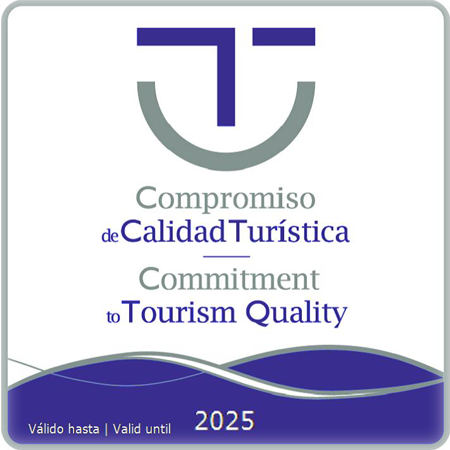 The Augusteum, a temple dedicated to Octavian Augustus, the first Roman Emperor, offers a chance to learn about the cult of worship of the emperor, the theatrical pomp and the displays of great wealth and prestige staged by the priests. The Augusteum was one of the instruments used to spread imperial ideology and as such was richly decorated, as can be seen in the quarried marble floors, now remnants of a bygone age of splendour.
The Augusteum, a temple dedicated to Octavian Augustus, the first Roman Emperor, offers a chance to learn about the cult of worship of the emperor, the theatrical pomp and the displays of great wealth and prestige staged by the priests. The Augusteum was one of the instruments used to spread imperial ideology and as such was richly decorated, as can be seen in the quarried marble floors, now remnants of a bygone age of splendour.
The Augusteum is very close to the Forum, where it is possible to explore this bustling meeting place and transit point which was at the hub of religious, administrative, political and economic activity in Roman cities throughout the Empire.
-
AugusteumThe roof decoration
-
AugusteumThe temple floor
-
AugusteumThe temple remains
High season (July 1 to September 15)
Tuesday to Sunday from 10:00 a.m. to 3:00 p.m.
Medium season (March 15 to June 30 / September 16 to November 1)*
Saturday and Sunday from 10:00 a.m. to 3:00 p.m.
Medium season (Easter)
Tuesday to Sunday from 10:00 a.m. to 3:00 p.m.
Low season (From November 2 to March 14)*
Saturday and Sunday from 10:00 a.m. to 3:00 p.m.
*The rest of the days open for groups with prior reservation.
The Augusteum is closed on the days:
- January 1 and 6 and December 25.
- January 5 and December 24 and 31 only in the afternoon.
* Opening hours are subject to change. Please check at destination.
** For special opening hours consult the Agenda .
*** Groups with prior reservation will have preference at the entrance turn.
Last access up to 15 minutes before closing.
General admission: €4
Reduced admission: €3
*Children under 12 years old, students up to 25 years old, Youth Card and Youth Card +, unemployed, pensioners, retirees, disabled, family (2 or more adults + 2 or more children under 12 years old ), large family card and groups of 20 or more.
Free entrance:
- Children under 3 years old.
- Official tourist guides.
- Members of the Cartagena Puerto de Culturas Club (except activities).
- Dolores bank holiday (local holiday).
**During temporary exhibitions or special activities, ticket prices may be modified.
ON-LINE PURCHASE
Approximate duration with exhibition: 45 minutes
Timetable:
- High season
11.00 and 13.00
- Mid season
11.00 and 13.00
- Low season
11.00 and 13.00
* These timetables are subject to modification: please consult before planning visits
Rules for Guided Tours (PDF - 422,33 KB - Fecha de revisión: 07/11/2024)
Free Online Booking
- Accessibility
Tourism for all is one of the main objectives of Cartagena Puerto de Culturas. We are working to ensure access for as many visitors as possible. At present, the Augusteum offers the following facilities for visitors with special needs:
- Not accessible for people with reduced mobility.
- Adapted toilets.
- Audio-visual with voice-off (in Spanish).
- Reduced rate for those with disabilities, presenting official proof at the box office.
- Guide dog access is allowed with the corresponding accreditation.
Historical context
The granting of the status of colony (Colonia Urbs Iulia Nova Carthago), probably in 54 BC, marked the beginning of an urban planning project which grew in scale during the reign of Augustus (63 BC to 14 AD) and continued under his successors. The first work focused on building and consolidating the defensive walls, as well as on designing a new road network adapted to the lie of the land of the peninsula, with its five hills, on which the colony stood. The new streets marked out the areas devoted to religion, leisure and civic and administrative activities, and among them was the meeting place par excellence, the Forum, and the buildings around it, including the curia - the local senate - and the Augusteum.
In the second half of the 2nd century AD the city began to decline, and when a recovery began in the 4th century it was only partial. Over the course of later centuries the buildings were plundered and destroyed, and the stonework became a quarry for the construction of other buildings.
The Augusteum
The visit to the site of the Augusteum begins with an exhibition space dedicated to the Forum, the nerve centre of the Roman city. Archaeological findings in recent decades have helped to pinpoint the location of the Forum in the present Plaza San Francisco. Based on the scarce remains it can be surmised that it consisted of a square, or public area, around which there were different buildings: the capitolium, a temple dedicated to the Capitoline Triad (Jupiter, Minerva and Juno), the curia or local senate, where the ruling class met, tabernae, or shops, and the Augusteum. The forum was built in a series of terraces with a clear symbolic function, and the temple’s location on the top level illustrated the hierarchy of gods and men. The plaza also played its part in this representative function, with the open area marked by statues, plaques and honorary pedestals dedicated to members of the imperial family and to the patrons of the city, thus demonstrating allegiance to the emperor and his wealth.
With regard to the Augusteum, this was the collegial headquarters where the emperor Augustus was worshipped. Although its construction was first believed to have been during the reign of Tiberius, it has recently been suggested that it actually dates from the second half of the 1st century AD, and was in use until the 3rd century, when it gradually fell out of favour and was eventually abandoned. Its supporters would have been the local elites linked to the circles closest to central authority.
The complex consisted of a porticoed patio entrance, a central area containing the statue of the emperor, two nymphaeum at the sides, possibly with fountains, two rooms related to the activity of worship and, finally, two shops separate from the place of worship. The outstanding feature is the richness of the ornamentation, the floors and walls lined with marble brought from quarries all over the Empire and an interesting collection of terracotta antefixae: these elements were located on the roofs of the porticoed sides of the patio that faced in towards the temple itself, and may be sorted into two groups, the first being theatrical masks in clear reference to the god Apollo and the second, with the winged symbol of victory flanked by two Capricorns, referring to the victory of Octavian Augustus in Actium.
At one end of the site are the remains of a double portico with lateral exedras. This type of portico was linked to the imperial cult and may have housed an altar for the veneration of the emperor Augustus before his worship was made official on his death. At the same location there is also a fragment of the defensive walls built by Felipe II in the 16th century.
Exploitation of the site
When excavations were being carried out for the construction of multi-level car park in Calle Caballero in 1991–92 two ancient buildings related to the Roman forum were found, the portico and the college of the Augustales (the priests instituted by Tiberius to maintain the cult of Augustus). After excavations directed by the archaeologist Luis de Miquel, it was decided that they should be conserved in the basement of the new car park building.
A few years later a plan was implemented under the Cartagena Tourism Promotion Plan to convert the remains into a museum space, which was eventually opened in 2002. In 2003 the management of the archaeological site was transferred to Cartagena Puerto de Culturas. The architectural adaptation was carried out by architects Nicolás Maruri, Atxu Amann and Andrés Cánovas.
The tour of the museum
- The Forum. Display cases show pieces recovered from the forum area belonging to the different buildings, including fragments of sculptures and ornamental pieces.
- The temple. Two areas help to understand the site: the exhibition area with panels and various artefacts, and the remains of the temple itself. In this area some polychrome columns which would have belonged to another Roman building are still standing.
Bibliography
- De Miquel, L. y Subías, E., (1999). “Un edificio de culto en la Calle Caballero (Cartagena)”, en XXIV Congreso Nacional de Arqueología (Cartagena, 1997), pp. 119-121.
- Gómez Vizcaino, A., (2003). “Las murallas de los Austrias en Cartagena (1500-1700). Fuentes documentales y testimonios materiales (cerro del Molinete, calles Adarve y San Antonio el Pobre y Monte Sacro)”, en J. M. Noguera Celdrán (ed.), Arx Asdrubalis. Arqueología e Historia del Cerro del Molinete (Cartagena), vol. I, Murcia, pp. 269-305.
- Noguera Celdrán, J.M., (2002). “Un edificio del centro monumental de Carthago Nova. Análisis arquitectónico-decorativo e hipótesis interpretativas". Journal of Roman Archaeology 15, pp. 63-96.
- VV.AA. (2009). “El Augusteum de la calle Caballero, nº 2-8”. Fora Hispaniae. Paisaje urbano, arquitectura, programas decorativos y culto imperial en los foros de las ciudades hispanorromanas. Monografía del Museo Arqueológico de Murcia. Actas del Seminario de Lorca (Murcia, 2002), pp. 268-273.
- VV.AA. (2009). “El denominado edificio A de la calle Caballero, nº 2-8: ¿una porticus dúplex?”. Fora Hispaniae. Paisaje urbano, arquitectura, programas decorativos y culto imperial en los foros de las ciudades hispanorromanas. Monografía del Museo Arqueológico de Murcia. Actas del Seminario de Lorca (Murcia, 2002), pp. 262-268.
- VV.AA. (2012). Cartagena Puerto de Culturas. Convirtiendo el pasado en futuro.
Contact
10 Gisbert St. 30202 Cartagena (Spain)Phone +34 968 500 093
Fax +34 968 529 298
Emails:
Social networks
The internet portals of the Hon. Cartagena City Council only uses its own cookies for technical purposes; they do not collect or transfer personal data from users without their knowledge. However, they contain links to third-party websites with privacy policies unrelated to those of said city hall portals, which you can decide whether to accept or not when you access them.
 Tripadvisor
Tripadvisor


